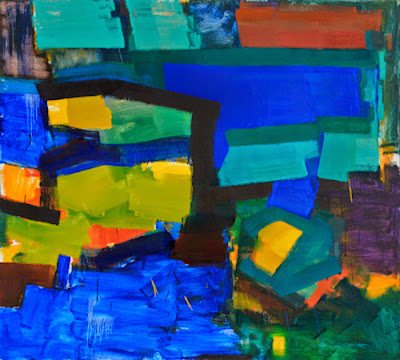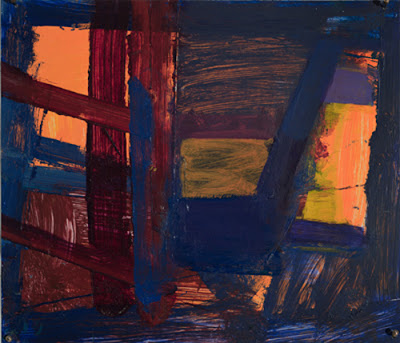The shortcuts and deep space of David Rich
 |
| Evening oil on canvas, 56 x 64 in. 2007 |
David Rich, Paintings
April 5 – June 2, 2013
opening reception: Friday, April 5, 6–9PM
Exhibition homepage
David Rich has taught painting and drawing at the Minneapolis College of Art and Design since 1985, and as a visiting artist throughout the US. He now paints full time in St. Paul and New York City. Rich is known for his decisive modeling of abstract pictorial space and for his distinctive style of urban nocturnal landscape.
 |
| Tell Me oil on canvas, 54 x 50 in. 2012 |
But it is not the matter of landscape and abstraction that draws us to the work of David Rich, but rather the optical and the non-optical in his work. Rich’s work has a stringency that avoids the assumed virtue of abstraction. There is in his work a restrained approach and an economy of means that signal other orders of event. The paintings are a pleasure to look at as abstractions and as landscapes, but they offer shortcuts as well to the artwork as a conceptual and non-optical matter — to “things not seen”, as Clarence Morgan aptly puts it in his essay for the catalog that is the principal reference on David Rich at present.
 |
| Neva Wuda Thunk It oil on canvas, 56 x 62 in. 2012 |
It is a creed of our gallery that painting should address the definition of the art object, as the conceptual artists did some 40 years ago. Matters of genre and lineage in painting as such are secondary. So we look for a painting that can free itself up from genre and a take hold of ideation.
Rich’s paintings amount to a kind of “index” of marking and noting. It is where abstraction verges upon hermeneutic concerns of language and conceptual art. In Rich’s shorthand, there is a cut-to-the-chase quality that feels like it gets under the hood of things, and does not abide the assumption of abstraction.
 |
| Configuration acrylic on paper, 9 x 10.5 in. 2012 |
Rich has codified abstraction in a way as to wrap up certain of its main issues, and then he also diagrams the outer conditions of the artwork — the material, labor, the ethics of the act. This he does with interventions that are sometimes self-effacing or boldly indifferent to the more optical aspects of the picture. A signature device in Rich’s work is his use of areas of black or deep dark colors to accentuate, lock in, or obliterate passages on the canvas. It invokes flatness, it trades with the “support” that was so important to American color field painters, and the motif of segmentation also draws out the question of an artwork’s organic unity as opposed to its potential disunity, its “rupture,” and so on.
 |
| Place of Open Intervals oil on canvas, 56 x 60 in. 2012 |
David Rich is a respected draftsman-instructor in the considerable world of abstract painting, and a draftsman whose work is committed to the initial proposition of the work of art, not to the perpetuation of a genre. And while “the initial proposition of the work of art” may elicit groans of familiarity, it is also the case that no really interesting contemplation of art is sustainable without it. Art as a species has never been exhausted or overcome by a critical strategy. Though at this point, “abstraction” may yet be overcome by the critical strategy of an artist who puts it to an unexpected use.
These canvases suggest a great deal of scoping, adjusting, and orienting within a renewed domain. That may be a fair enough description of what anyone seeks in a painting. But with the addition of David Rich to our gallery, I do feel we have come closer to articulating what a generalist and conceptualist approach to painting means. I call it a “shaken out” approach, which I assume is not lost upon other observers of painting today.
 |
| Little Painting for Charlie Stolerow acrylic on paper, 5 x 7 in. 2012 |
But if so-called abstract painting once again becomes the default case study for art theory, it stands to reason there might be a shakeup in the various orders of abstractionism. The jargon of abstraction may undergo distortions. Fundamental concepts may be understood in new ways. Once more the special history of painting passes through the general history of art, with both now having imbibed deeply from the wells of conceptual art and critical theory. Painting today is not the revivalist movement it was in the 1980s, where the medium was presented as a provocation by virtue of its being painting and not conceptualism. Now the onus is on the painter to be the conceptualist, and the focus of painting has shifted from style and allegory to include other structures of the artwork as well.
David Rich is a known quantity in circles of abstract painting since the 1970s, sometimes called post-abstraction, where the invisible dimensions of a canvas have been long considered. The 61-year old painter from Minneapolis has captured the interest of young painters in Brooklyn whose work is generalist in approach. And this may be owing to a stripped-down approach that is appealing to artists today who are looking for a new organizing principle for non-objective painting. Rich has reinvented abstraction as a notational form. He has taken from abstraction only as much as he needs to explore art as a general matter, but not enough to get him mired in the vicissitudes of a genre.
 | ||
Kulu Se acrylic on paper, 9 x 10.5 in. 2012
|
 |
| Cutting Light oil on canvas, 56 x 62 in. 2012 |
The small acrylic works in Rich’s studio on the Lower East Side are a bold, crackling suite of historicist forms, serialized across the room, cinematic, evanescent. Cinematic movement is key to Rich’s paintings. He is an artist who works often with negative space and deep space, and he uses surface space to index these complex, non-optical maneuvers. A frame-like, instantaneous mode of perception stabilizes the focus of his paintings upon more than one structure at a time. Filmic movement jump cuts across the canvas, revealing and effacing, in a shadow movement of the painting that is indifferent to optics, and uncompromising.
 |
| Night LES series 2013, acrylic |
 |
| Night Summer LES series 2013, acrylic |
 |
| Painting Creature LES series 2013, acrylic |
 |
| Interval LES series 2013, acrylic |
Painting is not just a matter of adding one thing after another in some sequence of calculated or spontaneous gestures. One must take aim, and the painting should be determined in the first stroke. All subsequent maneuvers are an interrogation of the initial impulse. This does not mean a premeditated painting, but it does mean a process that is reflexive, that tends toward reconciling itself with the “damage done,” so to speak, rather than to try to repair the damage with add-ons.
 |
| Warehouses and Water mixed media on paper, 10 x 12 in. 2006 |
 |
| Evening, Warehouses and Water oil on canvas, 42 x 40 in. 2006 |
Above are a canvas and a sketch from the David Rich catalog of 2010 that are good examples of the cinematic in his work. In the sketch, Warehouses and Water(2006), there is a touch of impressionism just to “cheat” the eye into position. Then in one punch come the frame, the ground, the raw material, as if shot through an old film projector at high speed. A similar effect obtains in the oil painting of the same year, Evening, Warehouses and Water, where a single frame of impressionism beats through the paint at cinematic speed. The vertical scratch of orange light along the side of the building captures the speed, locks the projector in a spasm, a lurch in time where we can grasp a point of velocity.
 |
| Intervals mixed media on paper, 12 x 12 in. 2007 |
In Intervals (2007) there is a bold argument in blue and black, overcast with a vapor of yellow rag-wipe, a bright orange ground lifting from the rear. The whole of the painting is keyed to a neat tie-off in the bottom third and a nudge to the left. At first pass it appears the yellow rag-wipe is a bit timid and arbitrary as painting. On second it becomes clear that it forms a pinwheel of highlights that rotates counterclockwise along an arch supported, indeed, by the bold argument in blue and black. The rotating highlights glide into the source of their light, which of course is in the axis of the tie-off in the bottom third.
There is complicated highlighting in Intervals. Strong passages of orange mitigate the pinwheel of yellow rag-wipe, yet are cold, though orange, for they staunchly belong to another order of events. Indeed, all of the orange passages in this painting are time-based process painting, and each is neatly pegged as such. The orange passages belong to a non-optical phase of the painting. Yet the yellow rag-wipe shares the light of the orange ground and matches it in tone. Still there is a long pull between the two colors. It is a dazzlingly controlled and balanced act that manipulates time and process as it goes.
 |
| Night Yard mixed media on paper, 11 x 11 in. 2009 |
Night Yard (2009) comes toward the end of the David Rich catalog. Again, only the barest amount of impressionism, the elemental reflection off the top of a roof. But the rest of the painting is disembodied metaphysics in a tar pit of negative space. A vacuum sweeps in around the rooftop. The land swells, the roof encapsulates, obtrudes into a polygon. A machined strip of blue zips down the right edge of the painting, against a fat blue brush-off along the top. Some lesser traces of darker blue modulate, and a welter of tarry black cancelation pounds into the canvas from all sides.
There is a crisp unraveling of light and layers on the left side of the painting, where another building is visible behind the rooftop. Here is revealed an editing process that slices like a letter-opener clear through the painting from the left edge. The glint of its blade is seen again on the right. Otherwise the painting is a vortex of negative space, a discourse of anti-matter, all of it wiped out in black perfunctory strokes, cutting few corners. What remains is what is arguable, what cannot be argued is passed over in silence.
David Rich’s paintings are circumspect and sure of aim. To my mind they account for a great deal of what defines a work of art, the visible as well as the process and what is suggested but not seen — the support, the intention, the act, the why, the gestures and their cancelations. It is not much more complicated than that. But it is an intellectual exercise at which David Rich is uncompromising. Things will be sorted out, come hell or high water, on his watch, is the message you get from this work.
— Ethan Pettit, February 2013

